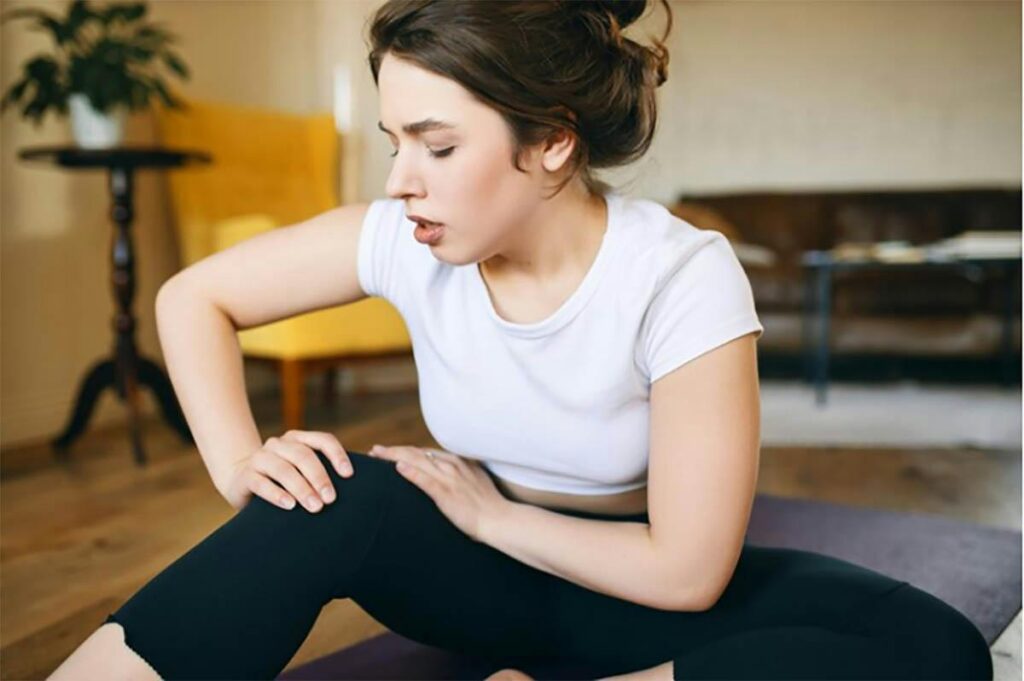Introduction
Knee pain when bending is a common issue that can significantly impact one’s quality of life. Whether it’s a sharp pain, discomfort behind the knee, or pain in the front, understanding the causes and effective treatments is crucial for those dealing with this issue.
Common Causes: Consider the Location of Knee Pain
Understanding the nuances of pain behind the knee when bending involves recognizing its location. Let’s delve into specific knee pain scenarios:
Pain Behind the Knee When Bending
Strained Tendons Overstretching or tearing of tendons can cause discomfort and limited flexibility during bending.
Baker’s Cysts: Fluid-filled cysts that form behind the knee, leading to swelling and exacerbating pain.
Injuries to Posterior Cruciate Ligament: Damage to the ligament at the back of the knee due to trauma or overuse can cause persistent pain, especially when bending.
Pain in Front of Knee When Bending

Patellar Tendonitis: Inflammation of the tendon connecting the kneecap to the shinbone results in anterior knee pain, particularly felt as pain in the front of the knee when bending.
Quadriceps Tendonitis: Inflammation of the tendon connecting the quadriceps muscles to the kneecap causes pain and stiffness in the front of the knee.
Patellofemoral Pain Syndrome: Pain around the kneecap due to issues like misalignment or overuse, resulting in discomfort.
Top of Knee Pain When Bending
Meniscus Tears: Tears in the cartilage (meniscus) cushion the knee joint, leading to pain at the top of the knee. Knee meniscus injuries are frequent, occurring at a rate of 61 cases per 100,000 individuals.
Ligament Injuries: Damage to the ligaments supporting the knee joint causing pain and instability during movements.
Arthritis: Inflammation of the knee joint, often affecting the top area, resulting in persistent pain and stiffness.
Sharp Pain in Knee When Bending
Acute Meniscus Tears: Sudden tears in the meniscus, causing sharp and intense pain.
Ligament Injuries: Acute injuries to knee ligaments can cause sharp pain during bending.
Loose Bodies in the Joint: Small fragments or debris in the knee joint that cause sharp pain and can interfere with movement.
Risk Factors That Can Increase This Type of Pain

Knee pain is a prevalent clinical symptom among adults, impacting approximately half of the population aged 50 and above. Various factors contribute to knee pain when bending, including the presence of sharp pain in the knee, factors such as:
Age and Joint Health
Aging contributes to an increased risk of knee pain during bending, primarily due to wear and tear on the joints, leading to conditions like osteoarthritis. Changes in joint structure, including the connection of muscle to bone and muscle weakness, make older individuals more prone to knee pain.
Previous Injuries
Previous knee injuries, like ligament tears or fractures, heighten the risk of pain during bending. Such traumas can result in lasting problems affecting knee stability and function. Individuals with a history of knee injuries may have compromised joint structures, making them more prone to discomfort.
Lifestyle Factors
Certain lifestyle choices, such as excess weight and inadequate activity levels, can cause knee pain during bending. Maintaining a healthy lifestyle, including weight management and regular exercise, is crucial to prevent such pain.
How to Diagnose The Causes
About 25% of adults experience knee pain, with its prevalence increasing by nearly 65% over the past two decades, resulting in around 4 million primary care visits annually.
Accurately diagnosing the causes of knee pain when bending is crucial in developing an effective treatment plan and seeking timely medical advice. This ensures a precise understanding of the underlying issue for targeted interventions. The diagnostic process typically involves a multifaceted approach that includes:
Physical Examination: A healthcare professional assesses joint stability, range of motion, and signs of inflammation during a thorough physical examination. This helps identify visible symptoms and guides additional diagnostic investigations for knee pain during bending.
Imaging Tests: Imaging techniques like X-rays, MRIs, or CT scans provide detailed views of the knee’s internal structures, aiding in the identification of issues such as fractures, ligament tears, or degenerative changes, crucial for understanding and diagnosing the medical condition accurately.
Laboratory Tests: Lab tests, including blood tests or joint fluid analysis, may be conducted to assess infection, inflammation, or underlying conditions contributing to knee pain. They complement physical examinations and imaging, providing extra insights into the knee joint’s overall health.
Symptoms Associated With Knee Pain When Bending
Understanding the symptoms accompanying knee pain during bending is crucial for comprehensively evaluating the condition. These symptoms offer valuable insights into the severity of the issue:
Swelling: Swelling around the knee, a common symptom with bending pain indicates inflammation. Recognizing it helps healthcare professionals identify causes and plan targeted treatments.
Limited Range of Motion: Limited knee motion, a result of structural issues like cartilage damage or joint inflammation, guides diagnostics for a precise understanding of the factors causing chronic knee pain.
Redness: Redness around the knee may indicate inflammation or increased blood flow, often linked to conditions like arthritis or infections. This visual cue of redness assists in identifying potential inflammatory processes, aiding in determining the underlying cause.
Treatments for Knee Pain When Bending
Effective treatments play a pivotal role in managing knee pain when bending. Let’s delve into specific strategies targeting distinct causes and symptoms.
RICE Method
Rest, Ice, Compression, and Elevation, known as the RICE method, are fundamental to managing acute knee pain. This approach helps reduce inflammation, promote healing, and address issues such as tight muscles.
Knee Strengthening Exercises
Targeted exercises play a crucial role in addressing knee pain by strengthening the muscles around the knee, especially beneficial for managing muscle imbalances. These exercises are designed to enhance stability and support, promoting improved joint health and facilitating better engagement in physical activity.
Physical Therapy
Professional guidance through physical therapy, under the supervision of a healthcare provider, can address specific issues, improve mobility, and prevent future occurrences. This tailored approach ensures comprehensive care, addressing factors like muscle imbalances and connective tissue health.
Knee Surgery
In severe cases, when dealing with various types of knee pain, including those arising from sports injuries, surgical interventions may be necessary to repair damaged structures and restore optimal joint function. Professional advice from a medical provider guides decisions on the most appropriate course of action.
Tips for Managing Knee Pain When Bending
Practical tips are essential for effectively managing knee pain during bending. Incorporating these strategies into your daily routine contributes to overall knee health and well-being:
Proper Body Mechanics: Mindful posture and proper alignment in daily activities are vital to reduce stress on the knee joint, preventing excessive strain during bending motions.
Weight Management: Maintaining a healthy weight is crucial to relieve pressure on the knee joints, reducing the risk of pain and discomfort during movements.
Supportive Footwear: Opt for shoes with good arch support and cushioning for effective shock absorption during repeated bending activities. Supportive footwear evenly distributes weight, minimizing knee impact for enhanced comfort.
Regular Exercise: Do muscle-strengthening exercises around the knee, emphasizing low-impact activities to ease pain. Regular exercises enhance joint function and overall knee health, ensuring comfort when performing activities.
How Alliance Rehab and Regen Can Help You
If you’re dealing with knee pain in St. Petersburg, contact Alliance Rehab and Regen for a comprehensive approach to alliance sports medicine. Our specialized treatment plans cater to individual needs, showcasing success stories highlighting our methods’ effectiveness in St. Petersburg physical therapy.
Conclusion
Dealing with knee pain when bending requires a nuanced understanding of its causes and appropriate interventions. By addressing the root issues and adopting proactive measures, individuals can regain control and lead pain-free lives.
FAQs
Q1: What should I do if my knee hurts when I bend it?
A1: If knee pain persists, it’s advisable to rest, apply ice, and consult with a healthcare professional for a thorough evaluation.
Q2: How do I know if my knee pain is serious?
A2: Persistent, severe pain, swelling, and difficulty in movement are signs that warrant immediate medical attention.
Q3: Should I go to the doctor if it hurts to bend my knee?
A3: Yes, consulting a doctor is crucial to determine the underlying cause and establish an appropriate treatment plan. Ignoring persistent pain may lead to further complications.

